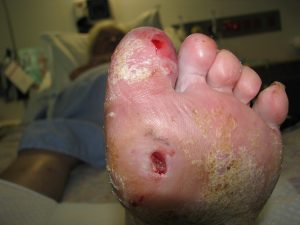 Diabetes-related foot disease is a marker for increased mortality, according to a retrospective study of more than 500 Indigenous and non-Indigenous Australians in the Northern Territory.
Diabetes-related foot disease is a marker for increased mortality, according to a retrospective study of more than 500 Indigenous and non-Indigenous Australians in the Northern Territory.
Most patients (94%) attending the Multi-Disciplinary Foot Clinic at the Royal Darwin Hospital between 2003 and 2015, and followed until 2017 or death, had type 2 diabetes with a median duration of seven years.
Almost half the patients were Indigenous (48%) and 30% were from remote areas of the Territory. The median age at first presentation was 56 years.
The study identified 199 deaths during the study period with a five-year mortality of 24.6% and a 10-year mortality of 45.4%. The most common causes of death were chronic kidney disease (CKD), cardiovascular events and sepsis.
Only age, CKD and low plasma albumin were associated with increased mortality in a multivariate analysis.
Factors such as ethnicity, a history of ulcers, macrovascular disease, anaemia and HbA1c were only relevant in the univariate analysis.
Other variables such as gender, remoteness, diabetes duration, ulcer characteristics, Wagner grade, amputation, hypertension, smoking, alcohol or other drug abuse, neuropathy, retinopathy, inflammatory markers, lipid levels, or insulin therapy were not associated with mortality.
The researchers said diabetes-related foot disease was being increasingly recognised as a predictor for increased mortality.
“Our study is the first Australian study conducted in a socially and ethnically diverse population to examine the mortality outcomes in patients with diabetic foot ulcers. It is also one of the largest studies worldwide,” they said.
While the five-year mortality rate was lower than in most other studies, it could perhaps be explained by the younger age and shorter duration of diabetes of participants in the cohort, they said.
They concluded that the presence of a diabetic foot ulcer should be seen as ‘an alarming signal to premature death’ and a prompt to initiate intensive risk factor reduction and close follow-up.